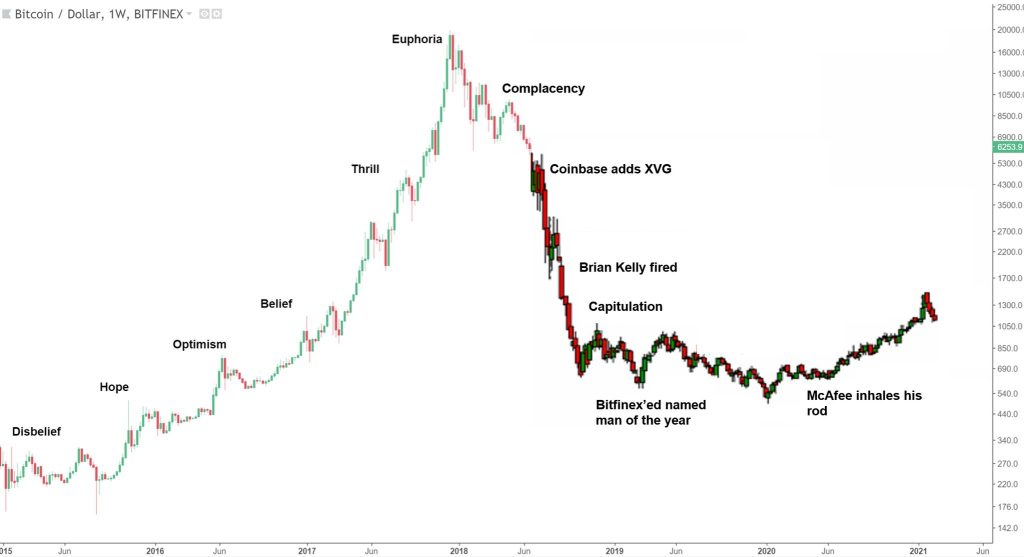2021-4-2 18:12 |
This week’s wNews digs into both the official arrival of institutions to crypto and the current market’s froth level. Finding signal in the noise was all the more hampered by April Fool’s Day, a horrific celebration.
Goldman Sachs announced on Wednesday that they would be rolling out a suite of Bitcoin-related products in Q2. Shortly after, Morgan Stanley reported the launch of a dozen funds that “may have access to Bitcoin indirectly.”
For many in the space, institutional inflows have been clear for some time. Goldman Sachs and Morgan Stanley have simply announced this fact to the rest of finance. Other parts of the market are just as bullish, but it seems less meaningful.
The TubbyCoin BigHugs! Token, an official Teletubbies cryptocurrency made with special HugTech from WildBrain Labs is here. For every like, share, comment of #TubbyCoin, the TubbyCoin becomes more valuable! Let’s take it to the moon. 🚀: https://t.co/CZJn5R7NI9 pic.twitter.com/B1Nt8OjFXe
— Teletubbies (@TeletubbiesHQ) April 1, 2021
Bitcoin and Ethereum put investors to the test this week, sending wave after wave of volatility. At the same time, both tokens also enjoyed some serious validation. Before titans of finance revealed their interest in Bitcoin, Visa confirmed that it would settle USDC on the Ethereum blockchain.
Now, ETH looks headed to new all-time highs.
Stay tuned to the end and learn more about how to interact with Web3 domain names.
All that and more, below.
Big Banks to Add BitcoinDuring this and last year’s market rally, a key talking point has been the arrival of larger institutions. Microstrategy, for instance, has been the poster child of this trend. Tesla and its CEO’s obsession with crypto, specifically Dogecoin, have added further fuel to the fire.
This week, though, Morgan Stanley and Goldman Sachs announced that they would roll out specific BTC products for their investors. This is significant because it adds a layer of formality to what Michael Saylor and Elon Musk have already been doing.
Instead of edgelords, the two CEOs now look more like strategic front runners.
The first hint came on Mar. 17, when Morgan Stanley revealed that they would assist their wealthier clients with exposure to Bitcoin. Only clients with $2 million or more held at the bank would be eligible.
This week, though, the bank announced the launch of a dozen different funds that would offer investors exposure to BTC. The exposure would not be direct but via futures contracts and Grayscale’s GBTC product. In the announcement, they said that Bitcoin offers investors “a low or negative correlation” to stocks and bonds.
Goldman Sachs is pursuing a similar narrative with its offering. On Wednesday, the bank’s digital assets lead, Mary Rich, said blockchain resembles the dawn of the Internet and that investors are seeking a “hedge against inflation.”
To answer these requests, Goldman will offer several alleged products. Some will include physical Bitcoin, while others will be derivatives, according to Rich. These offerings are expected by this summer.
Cryptocurrency enthusiasts were quick to celebrate on Twitter, having outpaced banks to the best game in town. What’s more, each bank has been a huge critic of the technology for some time. Now they’ve executed a near-perfect 180.
The timing is interesting too. In 2017, various signals began to emerge suggesting a top was clearly in. One clear exhibit was when CryptoKitties began selling for hundreds of thousands of dollars. Another was Ripple’s XRP breaching $3 a token with very little real traction or clear use case.
In 2021, many of these signals are also reappearing. Like so many smaller bubbles, the market is clearly frothy, but institutions are adding a new dynamic. Beyond a heady mousse, financial heavyweights are essentially underwriting the validity of the sector.
It would appear that the moon bois are now on Twitter and Wall Street.
A Side Note on “Flow”In their inaugural podcast episode, the team at Epsilon Theory dug into Bitcoin. During that conversation, Ben Hunt made an excellent point regarding the arrival of institutional money managers.
In sum, this demographic is not really that interested in how high or low the price of Bitcoin goes. The only thing that matters to them is something called “flow.”
Hunt explains that the real money is made when advisors get in between an asset and an investor. The easiest way to understand this is with something like a 2% management fee.
Grayscale’s GBTC shares, for instance, come equipped with precisely this. And for those who understand how compounding works, this 2% can cost investors a lot of money in the long run.
Firms will pocket this fee no matter what too. Bitcoin could be $5,000 or $100,000; it’s somewhat irrelevant. For them, the game is volume.
The more investors a bank onboards to the Bitcoin train via enticing products, the more fees they can accrue. Naturally, it’s much easier to attract new money to join when the market is green.
And in this way, don’t be surprised to see die-hard Bitcoin maximalists and investment bankers start to sound very similar.
Everyone wants Bitcoin to hit $100,000. The reasons why, though, are much different.
Market Action: Bitcoin (BTC)In March, Grayscale’s Bitcoin Trust shares traded at an average discount of -6.1%. The negative GBTC premiums have been a worrying signal for the market in terms of decaying institutional interest.
Because the funds are non-reedemable and include a six-month lock-in period, investors have been looking elsewhere for competing indices. These range from proxy Bitcoin stocks, bank portfolios, foreign ETFs, and regulated custodians in Fidelity, Gemini, Coinbase and others.
On CME, Bitcoin futures for August was trading at $62,500 this morning. The premium for April futures vs. the current spot price is 1.68%, suggesting that traders are bullish.
The mining hashrate has surpassed a new all-time high and is currently trading about 165 EH/s. The consistent rise indicates the addition of new machines to the network.
Bitcoin network total mining hashrate. Source: blockchain.comReportedly, used Antminer S19 models are selling above $10,000. The value is around the net one-year ROI for the S19.
Given that 89% of the BTC has already been mined, the exchanges, institutional custodians, and long-term “hodlers” have replaced miners as major stakeholders. Still, the mining industry trends can be a useful market indicator.
The hype in Bitcoin prices often creates a ripple effect across cryptocurrency-related stocks and hyperactivity in the mining industry.
The Puell Multiple, an indicator developed by on-chain analyst David Puell, helps to understand the rate of change of mining profits and their unsustainability levels compared to previous parabolic runs.
The ratio of daily issuance of Bitcoin (in USD) to the 365-day average value (in USD) is yet to reach 2017 and 2014 levels, suggesting that there is more fuel to this bull run.
Bitcoin’s Puell multiple indicator. Source: GlassnodeStill, the markets tend to punish overleveraged longs.
Bitcoin perpetual contracts’ funding rate has started to move above 100% apr, roughly 0.1% every 8-hours. The short-term volatility of the market increases strongly during period of high funding rates.
Bitcoin’s price exhibited a brief correction this week, falling to lows of $56,700 and taking out $600 million in liquidations. The amount is less than past ordeals in the billions.
Thus, traders looking for a breakout should see BTC past the previous ATH of $61,500 to expect a new wave of investments soon, or exhaustion will begin among short-term buyers.
Market Action: Ethereum (ETH)Ether futures’ daily trading volume on CME has held above $100 million since the last week of March. With Ethereum payments forming base layers at VISA, the platform has certainly found renewed bullish strength.
The exchange balance for ETH and BTC has been falling in tandem, suggesting buyers are scooping tokens off exchanges. The 30-day correlation between the top two cryptocurrencies is around 0.74.
Ether (pink) and Bitcoin (green) balance on exchanges. Source: GlassnodeEther has started to break out of resistance around $1,950, The target of the ascending triangle pattern is $2,850.
Source: Trading ViewWhile ETH has spent a lot of time in the $1,800-$1,900, its price has shown weakness above $1,900 in the past; ETH has closed above $1,900 only for nine days in total.
The $2,000 mark has become a significant psychological barrier for the number two cryptocurrency, much like Bitcoin’s $50,000 milestone. Notably, it took Bitcoin over 25 days to convert $50,000 from resistance to support.
A 12-hour close above the previous high of $2,050 should attract buyers into long traders further.
Crypto To-Do List: Register an Ethereum Domain NameThe crypto space has come a long way over the years. Once a fringe movement led by cypherpunks, cryptocurrencies have since grown to spawn a fully-fledged ecosystem. As the technology has evolved, the infrastructure surrounding Bitcoin and other crypto assets has vastly improved.
In Bitcoin’s early days, even using a wallet was a relatively complex process. Now, there are countless solutions that have made Internet money more accessible to the masses.
Though crypto wallet addresses are commonly perceived as a user experience barrier, today there are several ways to get a human-readable address for your crypto wallet. Such solutions work in a similar way to website URLs and email addresses.
Having a named address rather than a series of numbers and letters can have many benefits. They’re far easier to remember and alleviate the risk of mistyping a digit. They may also one day be supported by crypto apps in the future as adoption grows.
The most popular domain naming service for crypto wallets is Ethereum Name Service (ENS). It’s helped register over 231,000 names for 68,500 owners. Names can be registered with the suffix .eth.
ENS is used by many Ethereum supporters—even Vitalik Buterin has a wallet tied to vitalik.eth.
It’s also supported by applications like Coinbase, MetaMask, Etherscan, and Uniswap, and addresses for multiple cryptocurrencies can be stored on the same name.
ENS names are technically a form of NFT—they take the ERC-721 token standard. During a name’s registration period, the owner’s address gets translated by a smart contract called a Resolver.
Source: Ethereum Name ServiceRegistering a name is easy. To set one up today, follow these steps:
1. Search for your chosen name of three digits or more through the ENS app. Any unavailable names will not be possible to register.
2. Connect to a Web3 wallet such as MetaMask.
3. Request to register.
4. Wait a couple of minutes.
5. Complete registration.
For most names, a 1-year registration is capped at $5. A four-digit name costs around $160 per year, while a three-digit name costs $620 per year. If a name was previously registered by another owner, it has a temporary decreasing premium to dissuade name “squatters.”
The gas fee for registering a name depends on the network congestion. At publication, the fee was around $60. ENS, therefore, recommends registering on a longer timeframe: with the same gas fee, a 10-year registration for a name of five digits or more would only cost $108.
It’s possible to transfer to a new address after confirming, though it’s best to avoid making too many transactions to save on gas.
Once confirmed, the new readable address can be widely used across the Web3 ecosystem. Moreover, if Web3 achieves what it’s setting out to do, some ENS names could become significantly more valuable than their modest $5 price tag in the future.
That’s all for this week’s edition of wNews, readers. Stay tuned for next week’s dispatch.
Disclosure: At the time of writing, some of the authors of this feature had exposure to ETH, AAVE, BTC, UNI, and POLS.
Similar to Notcoin - Blum - Airdrops In 2024
LOVEcoin (LOVE) на Currencies.ru
|
|



















